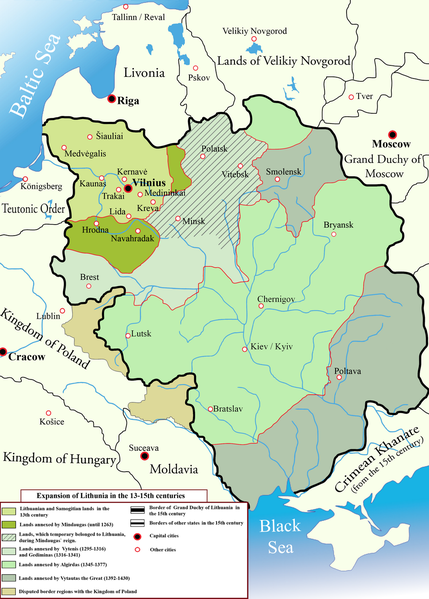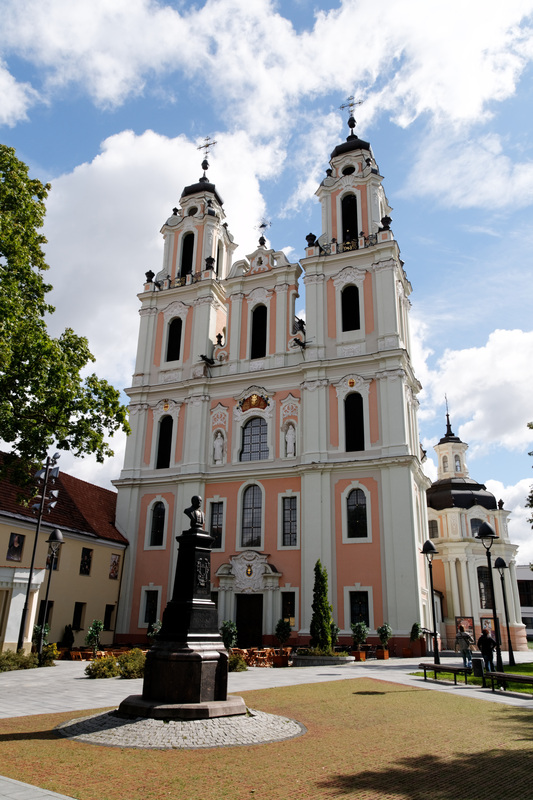A short history of the Baltic countries

Gediminas tower, Vilnius castle hill |
We don't know much about the history before the advent of writing in the Baltics in the 12th century. People moved here and there, language and genes shifted, they left pottery of various kinds. That's about all we know. Well, almost. We can say a little more.
We know that at this time various tribes roughly corresponding to what would become Estonians, Latvians, and Lithuanians lived roughly where they do now. The Estonians speaking a non-Indo-European language closely related to Finnish, the Latvians and Lithuanians speaking languages belonging to the Baltic branch of Indo-European. People lived in settlements protected by hill-forts. Many more hill-forts have been found in Lithuania than in Latvia and Estonia. Lithuania, being further south, had a longer growing season, and probably could support more people. Lithuania was also more politically centralized. This was about to become crucially important.
|
Baltic tribes, ca. 1200 (from Wikimedia Commons, user MapMaster) |
In the 12th century, two monastic orders of warrior monks, the Teutonic Knights and the Brothers of the Sword, moved into the Baltics. This is where the curtain rises and written history begins. The Sword Brothers founded Riga in 1201 and quickly subdued the surrounding tribes, Christianizing them with fire and sword. They later moved north and took what is now Estonia. But when the time came to go south for Lithuania, the Lithuanian ruler Mindaugas raised an army, and defeated them in the battle of Saulė in 1236.
Realizing that a tribal society could not hope to hold off mounted medieval knights forever, he embarked on a modernization of Lithuania. The old slave economy was abandoned, traders were invited, western military technology was imported, and the Grand Duchy of Lithuania was established.
This was a key juncture in Baltic history. Estonia and Latvia were now set for many centuries of rule by the Baltic Germans, who would eventually emerge from the monastic orders as the ruling class. The natives would be peasants and restricted from participation in rule and in many other ways. But Lithuania escaped this by establishing their own Pagan state, capable of holding off the crusaders.

Baltic area, ca 1250, from Wikimedia Commons, user SpaceCadet |
Thus the histories of Latvia and Lithuania diverged, even though they were closely related ethnically and linguistically. However, Lithuania's troubles were not over yet. The crusaders continued pushing from the north, while the Poles were attacking from the west, and Muscovy (soon to become Russia) attacked from the east.
So the next decades passed in continuous warfare, and, as a sign at the castle in Trakai said: "in this period, all resources were consumed by warfare." Remarkably, the Lithuanians succeeded in expanding all the way south to the Black Sea coast, but the cost was high, and it was clear that Lithuania needed an ally.

Grand Duchy of Lithuania, 1200-1430, from Wikimedia Commons, by M.K. |
Part of the problem was that Lithuania was still pagan, while its neighbours were Christian. Christianizing would take a lot of the pressure off, but would be deeply unpopular among Lithuanian nobles. In the end the solution presented itself: Grand Duke Jogaila married Jadwyga of Poland in 1386, thus becoming King Jagiello (the Polish form of his name) of Poland, and establishing the Jagiellon dynasty. Lithuania also converted to Christianity.
Thus the Commonwealth of Lithuania and Poland was established, for a while the biggest state in Europe. It solved Lithuania's problems in one way, but since Poland was much the more populous of the two countries, the state and the nobility slowly polonized. It also meant that while Latvia and Estonia turned Protestant, following the German elite during the Reformation, Lithuania together with Poland did not. So even today Lithuania is Catholic, while the north is Protestant.

Polish-Lithuanian Commonwealth, 1569, from Wikimedia Commons, by Mathiasrex |
The Commonwealth also had a fatal design flaw: the King was elected, and elected by unanimous vote among the nobles, which meant that any nobleman could stop an election. This lead to the Norwegian expression "polsk riksdag" (Polish parliament), meaning a meeting that is a riotous mess where nothing is decided. The result was a weak king, and confusion at times when the realm really could not afford weakness.
So eventually Russia absorbed Lithuania in the partitions of Poland, and the two northern neighbours a few decades earlier. By 1795, the state that had dominated the map of Europe for four centuries was gone. In Latvia and Estonia, however, the Baltic Germans remained as the ruling elite, and being by far the highest-educated group in the Russian Empire, provided the Czars with statesmen, scientists, generals, and administrators. A surprising number of famous "Russians" turn out, on closer inspection, to have been Baltic Germans.
Anyway, by the time of the World War I Lithuania was predominantly agricultural, while Riga was the main port of Russian trade, and the two northern provinces far more industrialized by the reforms of the Baltic Germans. The Czarist empire, already tottering, old-fashioned and autocratic, did very poorly in the war, losing all credibility with its citizens. Before the war was even over, the empire fell apart in revolution and civil war, which the three Baltic states exploited to establish independence.
After the unification of Germany in 1871 suspicion started to be cast on the loyalties of the Baltic Germans. These had no real alternative, however, to remaining strictly loyal to the Romanovs. After the 1917 revolution they found themselves pushed aside by the new Baltic nationalist movements, and stripped of their privileges. Having no love for the Soviet regime, and feeling dispossessed in their homeland, the vast majority left for Germany (particularly Prussia), thus ending seven centuries of German rule in the Baltics.

Vilnius baroque |
During the inter-war period, knowing they were in an exposed position, the three Baltic republics attempted to form various alliances, but for a number of reasons this fell through. So when World War II broke out, the front rolled over the Baltic countries several times, eventually leaving them in Soviet hands, to be incorporated in the Soviet Union as a three separate republics (in practice, provinces). However, they were not treated equally.
Lithuania had resisted the Soviets fiercely during the war, and the Forest Brothers continued armed resistance until forced collectivization of farming in 1951 finally reduced resistance. Stragglers fought on for years. This resistance meant that Russians were not very keen on moving to Lithuania, and since the country had very little industry Russian industrial workers were not moved in, either. After Stalin's death in 1953, the Lithuanian Communist Party quietly Lithuanianized itself, going from 1/3 Lithuanian to 2/3s Lithuanian in about a decade. So the Lithuanian Soviet Republic was for the most part run by Lithuanians themselves, while the other two republics were to a much larger degree run by Russians, and saw a Russian population influx that threatened to turn the natives into minorities in their own countries.
And then, eventually, the Soviet Empire was economically out-competed by the West, and the whole thing fell apart when Gorbachev tried to modernize it. Which leaves us where we are today, with a Lithuania that's quite different from its northern cousin Latvia. In fact, as late as the 1970s it was still not considered a Baltic state by everyone, but since the three countries have shared so many experiences from 1917 on, they're now all considered Baltic.
These differences had profound implications for beer, as we will see in the next blog post.

Red army soldiers, statue in Vilnius |
Similar posts
Why does Lithuania have such a great beer culture?
I think everyone will agree that for Lithuania to be one of the world's great beer cultures is a bit surprising
Read | 2013-09-30 14:19
Bakhchysarai
We took the elektryushka, the electric commuter train, out of Simferopol, through the lovely Crimean countryside
Read | 2014-03-09 12:35
The juniper mystery
When I started looking at farmhouse ale back in 2010, one of the first things that struck me was that nearly everyone seemed to be using juniper
Read | 2017-02-02 09:43
Comments
Bo Lindblad - 2020-07-13 11:49:54
Hei Lars, Som mange andre (tror jeg) skriver jeg mtp. tradisjonell ølbrygging. Har med glede lest «Gårdsøl» og som entusiastisk dokumentarfotograf planlegger jeg en tur til Latvia/Litauen ila. høsten 2020 for å lage miljøportretter av ølbryggene, dvs. visuell historiefortelling som dokumentere tradisjonell ølbrygging med særlig fokus på menneskene bak. Det jeg lurer på er om du kan hjelpe med kontaktinformasjon til ølbryggere i Latvia/Litauen? I Kveik-oversikten «Farmhouse yeast registry» finnes det flere spennende «farmhouse» som hadde vært interessant å komme i kontakt med, både i Latvia og i Litauen. Håper du kan hjelpe. På forhånd takk. Mvh Bo Lindblad
Rod Radovanovic - 2023-05-04 17:36:01
It is interesting how the history of Baltic states is missing hundred (or few hundred) years of being part of Russia.
I guess it is all because of Putin being so bad.
Lars Marius - 2023-05-04 20:39:00
@Rod: Read again. It's not missing.
Laurentius O. Zamoyski - 2025-03-27 16:31:29
> The Commonwealth also had a fatal design flaw: the King was elected, and elected by unanimous vote among the nobles, which meant that any nobleman could stop an election.
You're thinking of the liberum veto. It was not a matter of the royal elections, but debate over legislation in the Sejm. A single nobleman could, in principle, end discussion by protesting the legislation being debated.
It was more complicated in reality (the magnates held the most sway in practice), and so it was not really the fatal flaw that many people, including many Poles, have been led to believe it to be, as it worked successfully for centuries. The royal elections were also very peaceful and orderly.
It is only later in the 18th century, when the Commonwealth was already in decline, having suffered the major blows of the Second Northern War (the so-called "Swedish Deluge") and the Chmielnicki Uprising, that the liberum veto came to be abused by nobility who had been bought by foreign powers. The process was gradual, as the nobility gradually reduced the power of the Crown, which, in the 18th century, was very much needed to unify various factions.
The last king of Poland, Stanislaus Augustus, attempted to return the Crown to a hereditary institution, but it was too late, and the country was partitioned.